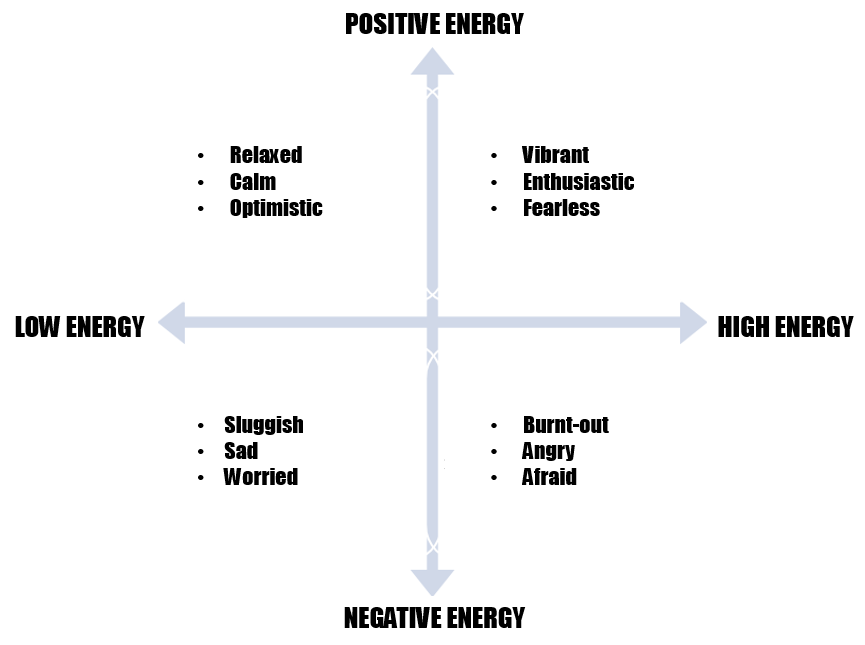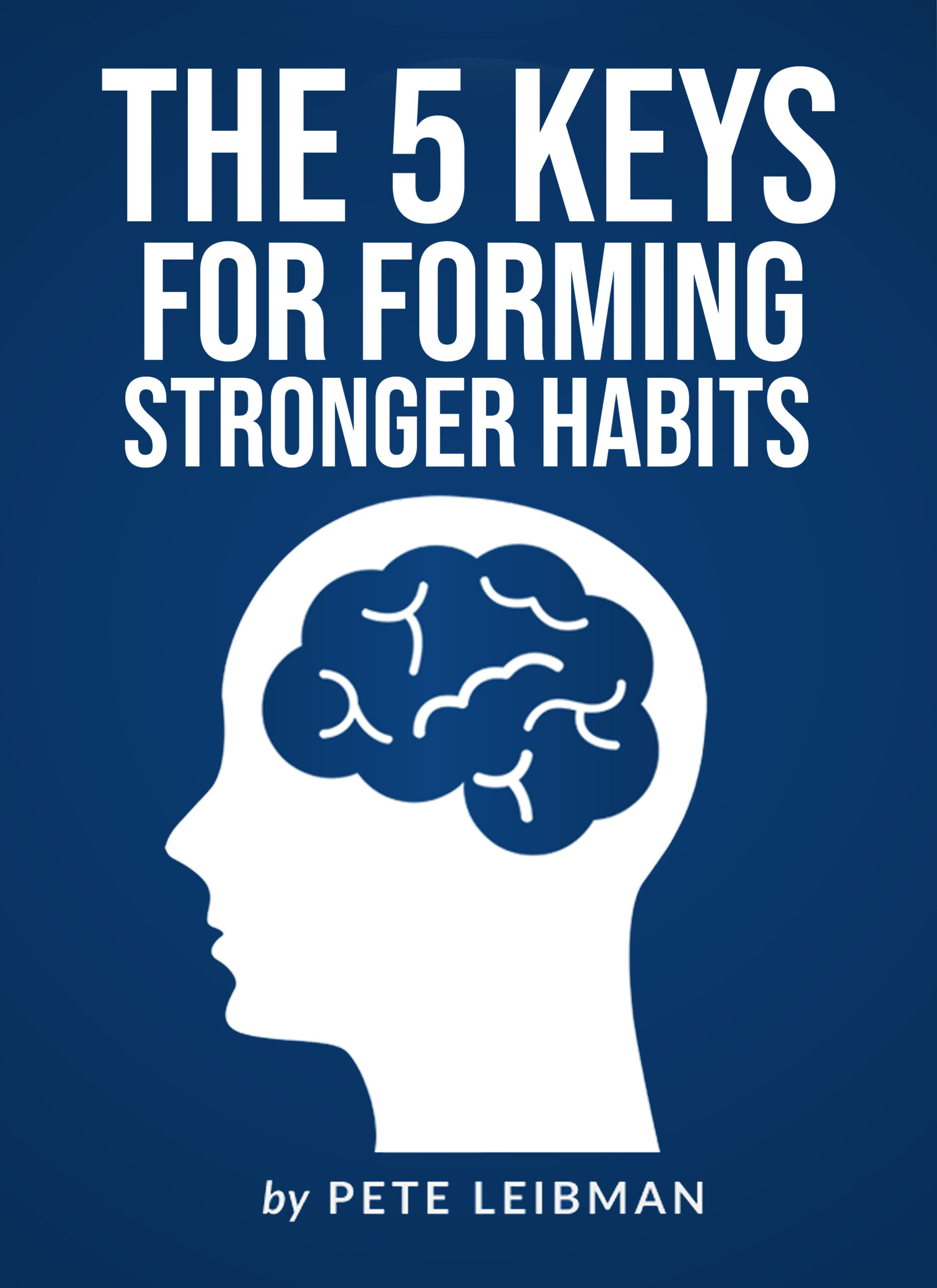
Let’s do a quick activity…
Take 30-60 seconds to write down (or think of) an answer to each of the following questions:
- What are some words that describe how you feel and behave when your energy is high?
- What are some words that describe how you feel and behave when your energy is low?
Yes, take a few moments to answer these questions before you read ahead. 🙂
When asked about how they feel and behave when their energy is high, most people respond with words like vibrant, enthusiastic, passionate, confident, or motivated. As for words associated with low energy, most people think of words like sluggish, tired, sad, worried, or unmotivated.
The 4 Energy Zones
When people think about their energy level, they usually only think it can be high or low (or somewhere in between). However, there are really four kinds of energy:
- High Positive Energy
- Low Positive Energy
- High Negative Energy
- Low Negative Energy

I first learned of the concept of four energy zones through an excellent book by Tony Schwartz titled Be Excellent At Anything; The Four Keys to Transforming the Way We Work and Live.
Schwartz flips the x axis and y axis in his energy zone quadrant, and he also labels and describes each of the four zones a bit differently than what you see in my image above. (Check out his book to view his quadrant.)
While there are some differences in our views and descriptions of the four zones, the key message is that there are four kinds of emotional and physical energy, and there are significant benefits to managing where you are at a given time.
Getting Into The (Energy) Zones
It’s wise to check-in with yourself throughout each day and ask yourself the following three questions:
- Which energy zone are you in now?
- Which energy zone would you like to be in?
- What could you do to get into that energy zone naturally?
At times, you will find that your energy is actually higher than you would like. For example, maybe you are feeling angry, and you want to calm down. Or, maybe you are feeling wide-awake, and you want to go to sleep.
Meditation, deep breathing, journaling, light reading, light stretching, yoga, or listening to peaceful music could all help you move into a low positive state in either of these scenarios.
You will also experience times when your energy is lower than you would like. For example, maybe you are feeling sad about something in your personal life. Or, maybe you are feeling sluggish because you had a heavy meal a couple of hours earlier.
In either case, you could get into a higher and more positive state by socializing with one of your favorite people, by watching an inspirational video clip, or by listening to some fast-paced music.
Physical activity can also be extremely effective for elevating your mood and energy- naturally and quickly. In one study, researchers at the University of Georgia even found that ten minutes of low-intensity activity (the kind that does not lead to sweating or require a shower) could make participants feel more energized than consuming 50 mg of caffeine, the amount found in a typical can of soda.
Common Themes with Your Energy Zones
It’s also wise to reflect on how much time you typically spend in each energy zone. Here are some additional questions to ask yourself:
- How much time do you typically spend in each energy zone at work?
- How much time do you typically spend in each energy zone outside of work?
- What are the most common triggers that cause your energy to be negative?
For example, I often wake up in a low negative state. Even after a great night’s rest, I often wake up and find myself worrying about something.
Rather than allow myself to wallow in this state, I learned years ago that starting my day with a focused, high-intensity workout almost always helps me move me quickly and naturally into a more positive zone instead. (Early morning exercise also provides additional benefits, as discussed here.)
Starting the day with exercise helps me get my mindset and energy level into a more positive place. However, you might find that a more peaceful activity works better for you at the beginning of the day. For example, many people like to start their day with quiet, reflective activity, like journaling or meditation instead.
The Benefits of the Different Zones
High positive energy provides many benefits. We often do our best work when we are vibrant, enthusiastic, and fearless. This zone is also where you usually want to be when you want to inspire or influence other people too.
However, the other zones can serve a purpose as well. The low positive zone is generally a good place to be during solitary and/or reflective activities. For example, I do most of my best writing while in a low positive state. Being too amped-up (high positive energy) would make it much more difficult for me to sit still and write.
In addition, there are times when negative energy can even be beneficial. For example, some coaches and athletes believe they perform better when they are angry. In fact, the motto for the Mens’ basketball team (the Shockers) at Wichita State University is “Play Angry.” This approach certainly seems to be working for the Shockers. They have made the NCAA Tournament every year since 2012, including a Final Four run in 2013 with victories over Louisville, Ohio State University, Gonzaga, and Pittsburgh.
Summary
Energy is not just high or low (or somewhere in between). Energy can be high positive, low positive, high negative, or low negative. In addition, more energy is not always better, and less energy is not always worse. There are times when decreasing your energy can actually be beneficial, such as when you want to be more reflective and when you want to prepare for sleep.
You have the power to determine when and for how long you find yourself in each energy zone. When you find yourself in a zone that is out of sync with where you want to be, ask yourself what you can do to move yourself into a better zone for that moment. Take control of managing your energy. Don’t allow your energy (or lack of energy) to control you.
P.S. If you enjoyed this article, you can share it by clicking one of the social media icons on this page.

Free eBook and Newsletter
Download my free 40-page eBook on “The 5 Keys for Forming Stronger Habits.”
You’ll also receive my free weekly newsletter on how to become your strongest self.
Your email is safe. Unsubscribe anytime.
About the author: Pete Leibman is the Creator of StrongerHabits.com. He is a best-selling author, keynote speaker, executive recruiter, athlete, and peak performance coach. His work has been featured on Fox News, CBS Radio, and CNNMoney.com, and over 500,000 people across the world have read his articles.

